How Utilising Animal By-Products Reduces Waste
How Utilising Animal By-Products Reduces Waste
During the meat production process, there is always going to be some parts of the animal that cannot be consumed. Bone, skin, fat and other parts of animals that cannot be used due to hygiene reasons or simply because they are visually unappealing, will be sent off to by-product rendering plants where they can be converted into a range of different purposes.
Utilising unusable parts of animals is a fantastic way to reduce waste and turn things that would otherwise have been thrown away, into a valuable commodity.
As we advance as a society, we have begun to adapt a ‘nose to tail’ approach to the meat we consume and even the parts of the animal we cannot. Once upon a time, meat by-products in the meat production industry were tossed away, whereas now, we have highly efficient that can turn even the most unappealing parts of the animal into useful products. For example, excess fat is trimmed off and turned into tallow which primarily goes to soap manufactures, cooking, biofuel and other industries as diverse as textiles, glues, lubricants and paints.
Blood and bones can be processed through rendering into dry powders which are used in a range of petfoods, poultry feed and fertiliser applications or to bone chips which are then processed to produce gelatin for photographic, food or pharmaceutical uses.
Blood isn’t just used for black pudding. It can be fractionated to plasma, albumin, globulin and hemoglobin which are highly valued proteins for nutritional and functional applications in the food and nutraceutical areas. Proteins can also be used in bioplastic manufacture.
This nose-to-tail approach has drastically reduced waste and become a vital part of our everyday life. Without this process, the meat industry could be one of the highest waste producing industries in the world.
Follow Us
All site audits are conducted independently and honestly.
The audits are a review of your rendering operation and the written reports provided create a valuable ongoing management tool.
Contact us today to find out more about how we can help optimise your by products plant and animal rendering business!
Rendering By-Products Australia
Phone: Mark Pope +61 455 220 320
ACN: 619 961 312
ABN: 20 619 961 312
P O Box 23241, Docklands Victoria 8012
👍 Facebook 👍
